Category: Music
Joshua Bell at Carnegie Hall
Pre-concert shopping event at The Conran Shop — all decked out for the holiday season. MarieBelle Chocolates and 10 Cane Rum concoctions added to the festive feel in the air.
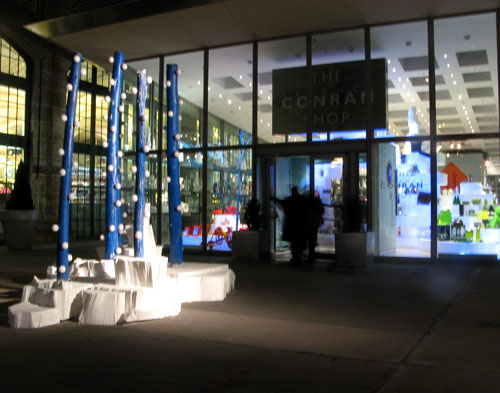
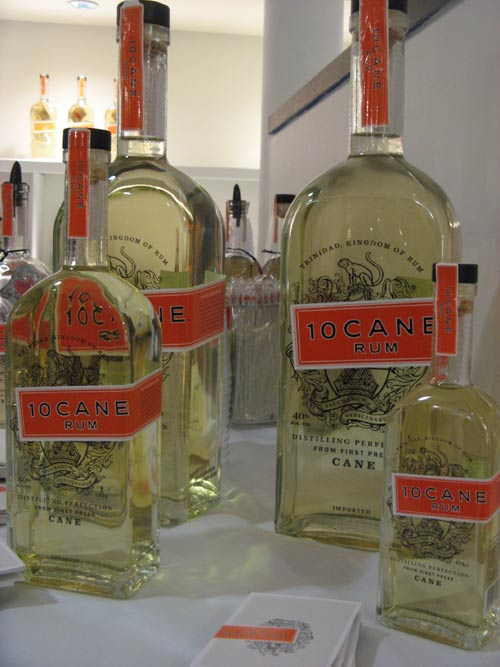
A quick stop at the adjacent Bridgemarket — the cathedral-like space beneath the Queensboro Bridge adorned with a canopy of Guastavino tile vaults — so named for Barcelona architect Rafael Guastavino, who pioneered the adaptation of a centuries-old building technology in which long flat tiles are laid and mortared together with a special mixture of cement and sand. Guastavino vaults can be found in several impressive interiors, including the eponymous Guastavino’s restaurant, the Oyster Bar at Grand Central Terminal, the U.S. Customs House and the Registry Room at Ellis Island.

And then to Carnegie Hall to see Joshua Bell, who would be performing the Brahms Violin Concerto that night. The ride on the crosstown bus was typically interminable, but we arrived with spare minutes to scarf down our dinner wraps in a vestibule across the street.
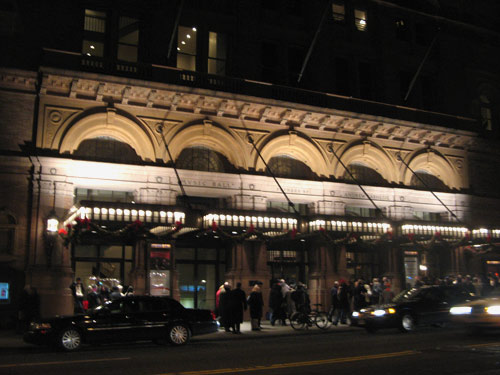
From our seats in the Dress Circle:
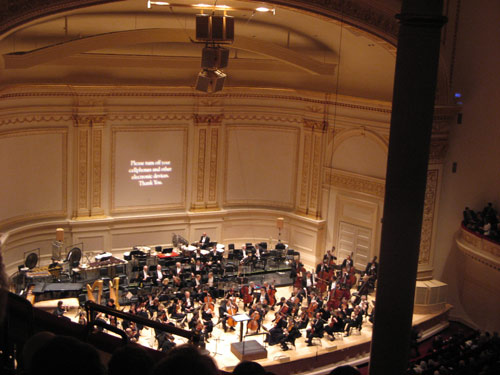
The concert began with Beethoven’s Coriolan Overture, Op. 62 and the New York premiere of Russian composer Sofia Gubaidulina’s Feast During a Plague — a work co-commissioned by the Philadelphia Orchestra and the Pittsburgh Symphony Orchestra (the latter of which was performing tonight.) SYB made a new friend with his droll commentary on the immense ensemble, and its large arsenal of percussion.
In his introduction, Sir Andrew Davis — no relation to conductor Sir Colin Davis — described the piece as “cataclysmic,” with its horn fanfares, growling brass, shrill bells and wailing strings. About halfway through the piece, a pre-recorded sound was introduced; a startled murmur rippled through the Carnegie Hall audience as the speakers blasted a completely unexpected techno beat — as if a convertible full of rowdy clubgoers had rolled in through the middle of the performance, blaring their tunes, stopping briefly before driving on. The beats reappeared in short bursts a number of times, as the orchestra continued on its path, before ultimately wrestling the rude intruder into submission.
After the intermission, the evening’s highlight: Josh Bell, performing one of the most important and technically demanding works in the violin repertoire. The Carnegie Hall program notes explained how Brahms, being a pianist and not a violinist, consulted his friend, violin virtuoso Joseph Joachim on the score in progress, asking him to “mark those parts which are difficult, awkward, or impossible to play.” (Ultimately, though, Brahms ignored some of Joachim’s suggestions for simplifying the violin part.)
Bell entered the stage like a rock star — clad all in black, with an open fronted shirt — and attacked the piece with great dexterity and passion. Always a joy to see and hear.
Anne-Sophie Mutter at Carnegie Hall
Another Carnegie Hall concert. This time, SYB and I decided to forego the usual pre-concert trip to Burger Joint in favor of something different. After weighing the alternatives, we settled on Pam Real Thai. SYB had never been there — which was a bit surprising since I’ve eaten there about half a dozen times in the last few months — so he was looking forward to making the Thai taste comparison. We arrived just before the dinner rush, and quickly decided upon Fried Tofu, Steamed Chive Dumplings and the Pad Key Mao (stir-fried flat noodle with beef, chili, basil and garlic, which we decided would be our baseline of comparison.) And of course, our flame-quenching Thai iced tea and coffee.
The noodles were far less incendiary than those we had on our other outings, probably because we did not specifically request “Thai spicy.” I have to admit that I did miss the heat, just a little bit.
As usual, a solid meal otherwise. Interestingly, in all the times I’ve been to Pam’s, I’ve never once ordered dessert. Maybe one day. Durian with rice pudding, anyone?

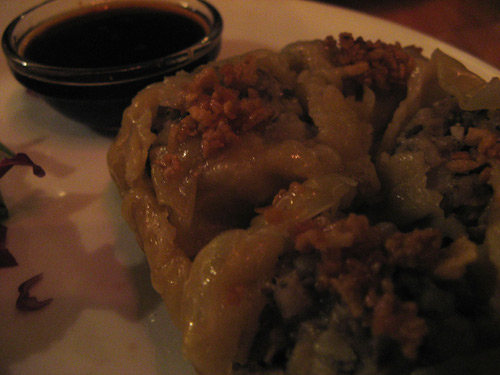
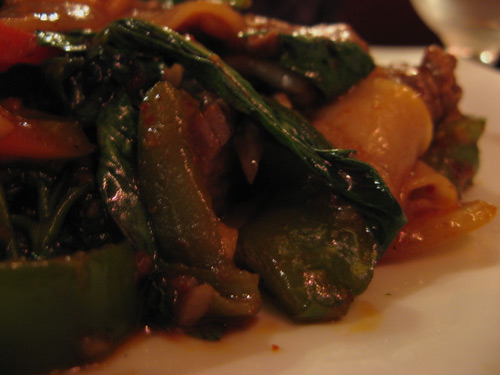
So we were back at Carnegie Hall for the second of German violinist Anne-Sophie Mutter‘s three all-Mozart programs. In honor of Wolfgang Amadeus Mozart’s 250th birthday, Mutter launched Das Mutter Mozart Projekt — an ambitious series of four new Deutsche Grammophon CDs containing all of Mozart’s major compositions for violin. To complement and promote the recordings, Mutter and her accompanist Lambert Orkis have been performing Mozart recitals all over Asia and Europe. This month, they conclude their tour in the United States, with concerts in St. Paul, Chicago, Boston, New York and Washington, D.C.
Tonight, Mutter was performing a set of five Mozart violin sonatas: the C Major, K. 296; the F Major, K. 377; the D Major, K. 306; the E-flat Major, K. 302; and the A Major, K. 526.
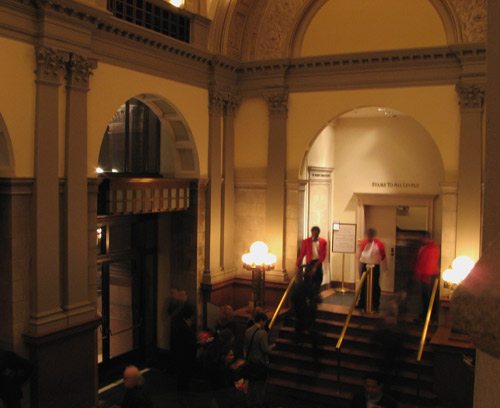
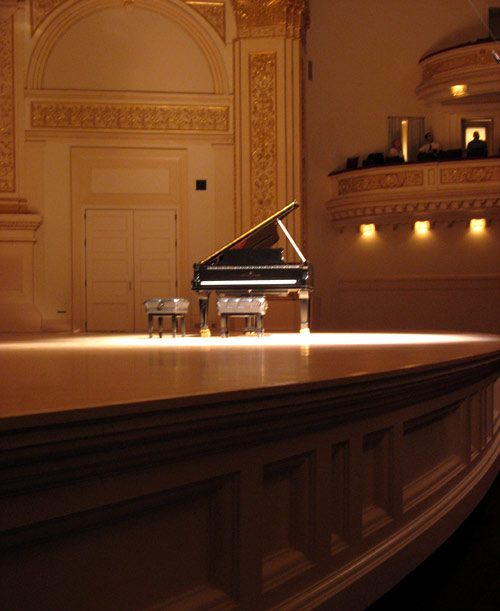
Mutter’s playing was dependably pretty (The New York Times quibbled: at times, too pretty, at the expense of texture and nuance) and technically prodigious. Mutter is known among classical musicians as something of a diva. She lends an undeniable star power to any concert, and few soloists attack their Strads the way she does. She’s a dynamic — and let’s face it: strikingly beautiful — performer. 2006 also marks the 30th anniversary of her debut at the Lucerne Festival, where she was discovered as a 13 year old. A year later, she appeared as a soloist at the Salzburg Whitsun Festival under the baton of flamboyant conductor Herbert von Karajan. The German popular press has covered her avidly ever since: through her marriage, while in her twenties, to Detlef Wunderlich, von Karajan’s lawyer and tax adviser who was then more than twice her age; after Wunderlich’s death from cancer in 1995, her second marriage to the oft-wed, also much senior pianist, conductor and composer Sir André Previn in 2002; their subsequent divorce in August of this year. (The former couple continues to collaborate professionally.)
In addition, there has been occasional grumbling over Mutter’s seemingly out-of control salary demands; it’s reported that she earns over $3 million performing sixty dates a year. For two seasons in the early 1990s, Mutter was effectively blacklisted from performing in London for refusing to cut her standard £10,000 performance rate. She eventually discounted her price, earning herself back in the London Symphony Orchestra‘s good graces. A good investment: the LSO booked her Mozart Project sonata cycle, and is paying the star a budget-busting £30,000 for each of three concerts. Compare that to the £25,000 per year earned by the second violinist of Hallé, Britain’s longest-established symphony orchestra, after fifteen years tenure. Do celebrated soloists have a moral obligation to subsidize their fees to assist financially struggling institutions?
Our seats this night were not quite second row center, but rather second to last row. Still on the parquet, though, and for $10, no complaints. And Mutter came out for one encore, before taking her final bow.
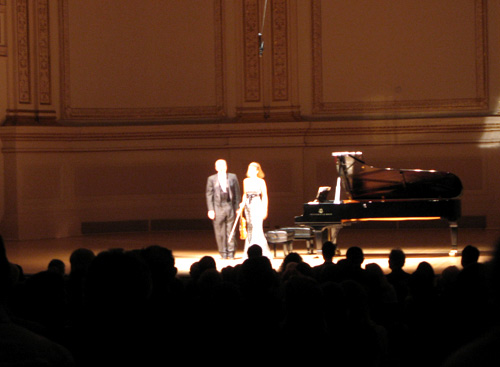
One hell of an Elixir
At the New York City Opera tonight.
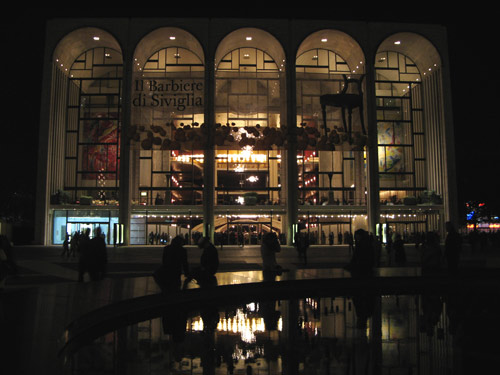
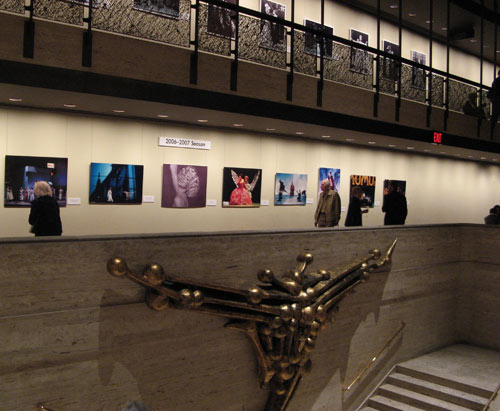
SYB got us tickets to tonight’s performance of Gaetano Donizetti‘s L’Elisir d’amore (The Elixir of Love). Sir Jonathan Miller’s new production — shared between the New York City and Royal Swedish Operas — is another of the director’s signature updates; Miller transplants the action in this Elixir from a 19th century Italian village to a 1950s high desert truck stop. The young hero, Nemorino (John Tessier), is transformed from a local villager to the town mechanic, donning the occasional cowboy hat. The local beauty for whom he pines is Adina (Anna Skibinsky in her company debut), who runs the roadside diner emblazoned with her name. Nemorino’s rival in love, the pompous soldier Belcore (Paulo Szot), is clad in Korean War-era Army fatigues; Dulcamara (Jan Opalach), who sells the titular elixir — actually, as he informs us in an aside: Robitussin — becomes the proverbial snake-oil salesman in his shiny blazer. The rest of the cast was outfitted in fitted floral dresses, jeans, leather jackets, pompadours and curler-set hair; at one point, a massive, flashy-finned Chevy convertible rolled onto the stage.
Our view from the first ring:
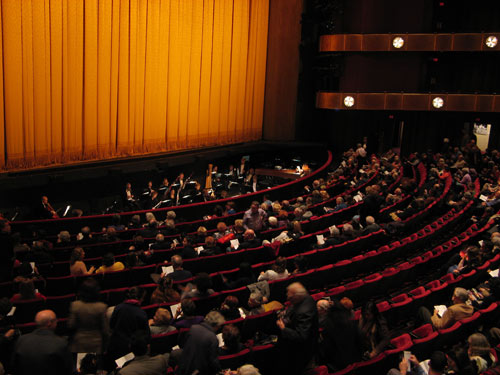
I’d enjoyed these whimsical, contemporary touches in the past. J and I attended Miller’s Mikado several years back, which was reset in an Edwardian English seaside resort; his Rigoletto played like a Mafia drama, unfolding in 1950’s Little Italy. (“La donna è mobile” blared on a jukebox.)
The performers sang in the original Italian, hamming up the action pretty admirably (taking a break only for the tenor showpiece “Una furtiva lagrima“), but the biggest laughs were elicited by the updated supertitles: lots of “dames,” “dolls” and “Daddy-O”s. To explain the legend of the elixir: “There was this chick named Isolde, and Tristan went ape over her.”
SYB noted that it was most fun he’d ever had at The Opera. Not for purists, though.
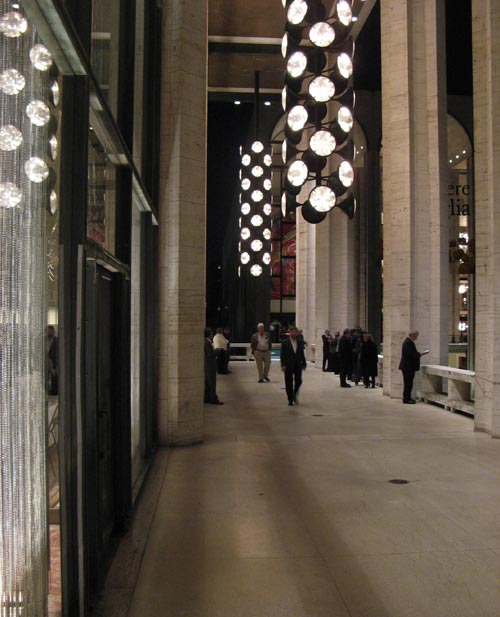
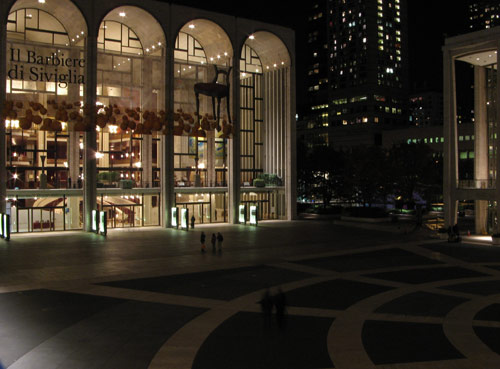
| S | M | T | W | T | F | S |
|---|---|---|---|---|---|---|
| 1 | 2 | |||||
| 3 | 4 | 5 | 6 | 7 | 8 | 9 |
| 10 | 11 | 12 | 13 | 14 | 15 | 16 |
| 17 | 18 | 19 | 20 | 21 | 22 | 23 |
| 24 | 25 | 26 | 27 | 28 | 29 | 30 |
Search
Popular Tags
Categories
Archive
- July 2010
- July 2009
- January 2009
- November 2008
- September 2008
- August 2008
- July 2008
- June 2008
- May 2008
- April 2008
- March 2008
- February 2008
- January 2008
- December 2007
- November 2007
- October 2007
- September 2007
- August 2007
- July 2007
- June 2007
- May 2007
- April 2007
- March 2007
- February 2007
- January 2007
- December 2006
- November 2006
- October 2006
- September 2006
- August 2006
- July 2006
- June 2006